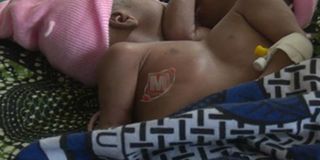Tanzania: School teacher gives birth to triplets, two conjoined

What you need to know:
- The woman who gave birth to rare twins was among two pregnant women admitted at the facility after being referred from Nyang’hwale District on March 17.
Geita. A primary school teacher, Theodora Wilson, has given birth to triplets, two of them are conjoined.
The conjoined twins, who are joined on the upper part of the chest were born on March 17 through Surgery at Geita Regional Hospital.
The separate newborn [who wasn’t conjoined] is 2.6kilograms while the conjoined ones weigh 4.5 kilograms in total. All are female, reports indicate.
Conjoined twins are an extremely rare phenomenon. Their occurrence is estimated to range from 1 in 49,000 births to 1 in 189,000 births according to a 2012 report titled: "Clinics - Importance of angiographic study in preoperative planning of conjoined twins: case report"
Most live births of conjoined twins are usually female, with a ratio of 3:1, says the report.
In the latest case, the woman who gave birth to the rare twins in Geita was among two pregnant women admitted at the facility after being referred from Nyang’hwale District on March 17, said Dr Joseph Makuma from the hospital’s department of Obstetrics and Gynaecology.
The two patients had been referred to the facility due to anaemia.
Dr Makuma said the nurse who assisted Ms Wilson to give birth was caught by surprise during the process.
“Soon after taking out the first baby, the nurse who was assisting in the delivery was surprised when she realised the mother’s tummy was still large in size. When I was called in to examine her, I found out that there were still two unborn babies,’’ explained Dr Makuma.
Dr Makuma recalled how the surgical team had to intervene to save the babies and the mother.
“One of the conjoined babies was already trying to come out of the birth canal, but it had taken one hand out. This was a risky situation. We had to carry out an emergency Caesarin Section,” he explained.
He added: “Thankfully the procedure was successful, but we realised that the two babies, weighing 4.5 kilograms in total, were conjoined and in good health.”
Dr Makuma explained that although the babies were joined on the upper part of chest they were not sharing any internal organs.
The mother of the babies, Ms Wilson, said she was hopeful as the two babies were born according to God’s plan.
She appealed to the government to extend her maternity leave so that she could take care for the newborns. She also requested for financial assistance in case the two babies would need to be separated.
According to medical experts, surgery to separate conjoined twins may range from very easy to very difficult depending on the point of attachment and the internal parts they share.
The Geita conjoined twins and one separate twin, all have been transferred to Bugando Medical Centre (BMC) in Mwanza Region for further expert management.
Recently in Tanzania, cases of conjoined twins have been widely reported.
Over a week ago, it was reported in the local press that formerly conjoined twins, Maryness and Anisia, who were successfully separated in Saudi Arabia were in stable condition and would be returning to Tanzania soon.
How do conjoined twins form?
One explanation is that a single fertilized egg does not fully split during the process of forming identical twins.
Another theory, according to scientists, has been that a fusion of two fertilized eggs occurs earlier in development.
However, it has not been possible to draw firm conclusions about conjoined twins and cases remain rare.




